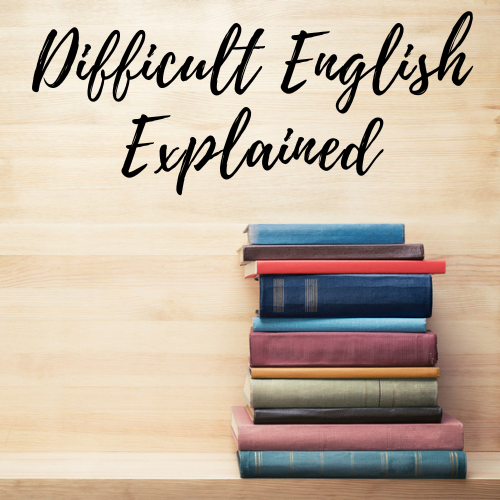Be sure that you read the first post in this series! You can find it at What comes after a verb? “To do”, “do,” or “doing”? (Part 1)

Students regularly ask me, “How do I know what comes after a verb?” There is no simple answer to this question, but there are some guidelines. Some of the trickiest kinds of verbs are those that have other verbs as complements. When a verb is a complement, it can be in one of three forms — a full infinitive (like “to do”), a bare infinitive (like “do”), or a gerund (like “doing”).
If a verb takes another verb as a complement, it is usually either a full infinitive or a gerund. Bare infinitives can only be complements for a small number of verbs, but these verbs are very common. Let’s look at some verbs that take bare infinitives as complements.
Modal Verbs
Modal verbs express:
- the speaker’s beliefs.
- the speaker’s attitude about whether something is possible.
- the speaker’s ideas about a potential activity.
The following modal verbs take bare infinitives as objects:
- can, could
- will, shall
- must
- may, might
- should
- would (if we are talking about a habit in the past)
Remember that, unlike other verbs, modal verbs do not show subject-verb agreement. Here are some examples:
- The test may be (It is possible that the test will be difficult.)
- Students may not use a calculator during the test. (Students are prohibited from using calculators.)
- I can study all night if necessary. (I have the potential to study all night.)
- You should study harder if you want to pass the test. (I believe that you are not studying enough.)
Some verbs are followed by a clause that has a bare infinitive. A clause, at the very least, has a subject and a verb. It can be independent or dependent. All the examples that I will show below are dependent clauses.
Causative Constructions with “Have” and “Make”
When we use “have,” and “make” in causative constructions, they must be followed by a clause with a bare infinitive. A causative construction shows one agent causing another agent to do an action. For example:
- I had the barber cut my hair. (The barber cut my hair because I wanted him to do it.)
- The complement of the verb “have” is “the barber cut my hair.”
- I made my daughter take a bath. (My daughter took a bath because I wanted her to do it.)
- The complement of the verb “make” is “my daughter take a bath.”
Causative constructions with “have” and “make” are very common in spoken English. Remember that English-speaking people tend to be specific about who did an action. If you say, “I cut my hair,” native speakers will assume that you did the action, not a barber or hairdresser.
Let and Help
“Let” and “help” follow the same pattern as “have” and “make.” They are followed by a clause with a bare infinitive. For example:
- The teacher let the students take a break.
- The complement of “let” is “the students take a break.”
- My friend helped me repair my car.
- The complement of “help” is “me repair my car.”
Verbs of Perception
In American English, the following verbs of perception take bare-infinitive clauses as complements: see, watch, feel, and hear. For example:
- I saw him leave the building.
- I see him leave the building every afternoon.
- Mary heard her sister close the door.
- I watch my daughter get on the school bus every day.
- I felt the floor shake during the earthquake.
These verbs are different from the earlier examples because it is also possible to have a gerund clause as a complement. For example:
- I saw him leaving the building.
- Mary heard her sister closing the door.
If we use a bare infinitive as we did in the first set of examples, it means that we think of the action as a single event. If we use a gerund, there is a subtle difference in meaning. If the main verb is in the past tense, it means that we think of the action as something that happened over a period of time. Gerunds show actions that are ongoing and/or incomplete.
If we use the verbs “see” and “hear” in the simple present tense, and the action is happening now, the gerund is mandatory.
- Look! I see them entering the building.
In this case, the gerund is showing an incomplete action.
To recap, there are a limited number of verbs that take a bare infinitive as a complement. The modal verbs that I covered take a bare infinitive verb as an object. The others take a clause with a bare infinitive verb as an object.
References
Endley, Martin J. (2010) Linguistic Perspectives on English Grammar: a guide for EFL teachers. Information Age Publishing. Kindle Edition.
Huddleston, R. D. & Pullum, G. K. (2002) The Cambridge Grammar of the English Language, Cambridge, England: Cambridge University Press.
Larsen-Freeman, D. & Celce-Murcia, M. (2016) The Grammar Book: Form, Meaning, and Use for English Language Teachers, Third Edition. National Geographic Learning, Boston, MA, USA
The Britannica Dictionary, https://britannica.com/dictionary
Oxford Learner’s Dictionary, https://www.oxfordlearnersdictionaries.com/ (Accessed Feb. 20, 2023)
Did you like this blog post? If so, support this content with a donation through Buy Me a Coffee!
Get notifications of new blog posts on my Telegram channel. Register at https://t.me/diffengexplnd
